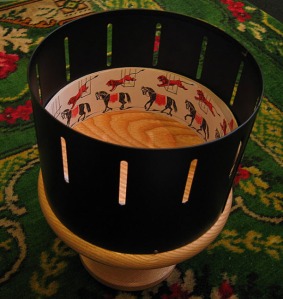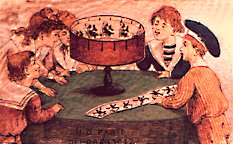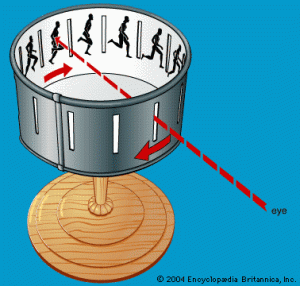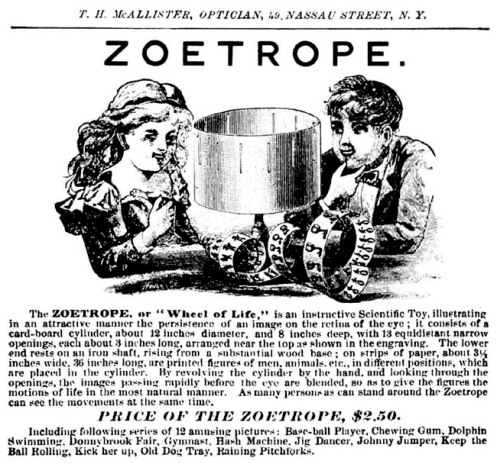about zoetropes
The zoetrope is an optical toy that produces an illusion of motion from a rapid succession of static images.
The zoetrope was invented in the early 19th century. Pierre Desvignes, a French inventor, brought the concept to France and gave the device its name – formed from the Greek words “zoe,” meaning life, and “tropos,” meaning turning. The word zoetrope therefore can be taken to mean “wheel of life” or “living wheel.”
The traditional zoetrope consists of a cylinder with slits cut vertically in its sides and a series of sequenced images on its inner surface. As the cylinder is spun, the viewer looks through the slits to the opposite side of the interior. When viewed in this way, the images are seen by the eye in such rapid succession that they produce the illusion of motion.
This illusion is created by an optical phenomenon called “persistence of vision” and something called “beta movement.”
“Persistence of vision” refers to the fraction of a second that the eye’s retina retains an image after it has disappeared from view. The retina perceives a flash of light for a full tenth of a second after it has ended, so if a light flashes every tenth of a second or less, the retina will perceive the light as shining continuously.
“Persistence of vision” is a stroboscopic effect meaning the images you are viewing must be separated by moments of darkness. The slits function in this manner, simulating flashes of light and creating a kind of strobe effect. In fact, modern zoetropes often use strobe lights to create the same illusion.
But because the eye is not identical to a camera, and vision is not as simple as light passing through a lens, the brain needs more than “persistence of vision” to be convinced that the images are in motion.
Beta movement, one of the phi phenomena, is the extra piece of the puzzle. Beta movement is a perceptual illusion in which the brain creates a relationship between two or more still images viewed in succession. The brain makes the assumption that they are one image which has changed positions, rather than the truth, which is that they are completely separate images. Beta movement is the result of our brain’s desire to see relationships between consecutive images, regardless of their differences, and make sense of the data provided by the eye in order to construct a coherent understanding of reality.
The concept of the zoetrope is related to other optical devices like the flip book, the thaumatrope, the praxinoscope, the phenakistoscope, and the electrotachyscope, amongst others.






Hi,
We would like to use your Venezuela square photo on our website. Is the all right? We will give you credit for the photo on our website.
Many thanks,
Hi – sure no problem so long as you link back to my blog 🙂 I’m glad you like it!
Oh hey I just wanted to stop by and say I really like reading your blog!
The advertisement you have above of the zoetrope, the one with the two children, do you know where it comes from? Thanks.
Hello,
I thought you might be interested to know that I have started work on a new website, The Wheel of Life. The subject is 19th-century sequence-picture optical toys.
The Home page is here:
http://www.stephenherbert.co.uk/wheelHOME.htm
this links through to the main essays.
The Contents list is here:
http://www.stephenherbert.co.uk/wheelComing.htm
this links to other pages.
There’s lots still to do to get the basic website finished (links to image sources, more main essays, etc) and then I’ll try to add something every month.
I hope you enjoy The Wheel of Life as it develops, and I’m always pleased to hear comments, and learn new things about the subject.
Best wishes,
Stephen Herbert
hudzo 2002 https://www.youtube.com/watch?v=ljFqF-TCBok
Hello, May my son print out your Zoetrope information for his science project? He will definitely list you as the reference.